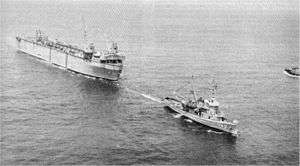USS Oak Ridge (ARDM-1)
 USS Oak Ridge (ARDM-1) under tow arriving in Spain | |
| History | |
|---|---|
| Name: | USS ARD-19 |
| Builder: |
|
| Laid down: | 1943 |
| Commissioned: | 22 March 1944 |
| Decommissioned: | 30 September 1949 |
| Recommissioned: | 1 October 1963 |
| Renamed: | USS Oak Ridge |
| Reclassified: | ARDM-1 |
| Namesake: | Oak Ridge National Laboratory |
| Decommissioned: | 10 August 2001 |
| Struck: | 26 November 2001 |
| Fate: | transferred to the United States Coast Guard, 8 February 2002 |
| History | |
| Acquired: | 8 February 2002 |
| Homeport: | |
| General characteristics (as built) | |
| Class & type: | ARD-12-class floating dry dock |
| Displacement: | 6,800 tons |
| Length: | 491 ft 8 in (149.86 m) |
| Beam: | 81 ft (24.7 m) |
| Draft: | 33 ft 3 in (10.13 m) |
| Propulsion: | None |
| Armament: | |
| General characteristics (as refit) | |
| Class & type: | ARDM-1-class |
| Displacement: | 9,700 tons |
| Length: | 536 ft 1 in (163.40 m) |
USS Oak Ridge (ARD-19/ARDM-1), was originally an ARD-12-class floating dry dock suitable for docking destroyers, submarines and landing craft. In the early 1960s she was upgraded to support Los Angeles-class submarines, and re-classified as ARDM-1-class. Self-propelled but unable to cross the ocean under her own power, she was towed, in stages across the Pacific. While in transit she was used as a van to help move the service squadron forward and at the end of August 1944 arrived at Seeadler Harbor carrying a YTL, 2 pontoon crane barges, and 20 LCMs and LCVPs. From Manus ServRon 10 provided the logistic support for the Palau offensive, then moved itself forward to Ulithi and Kossol Roads. The Leyte landings soon followed and the repair facilities were moved up to San Pedro Bay.
On 27 November 1944 ARD-19 was moored in that bay with USS Ross (DD-563) in dock undergoing repairs. Shortly before noon the Japanese launched an air attack. A "Tojo" fighter crashed into the drydock, passed through the starboard wingwall of the dock, and caused gasoline fed flames to encompass the dock basin deck, searing Ross as they spread. As the fire was being contained another Japanese fighter commenced a strafing run, but was splashed by gunfire from the ARD, Ross, and LST-556. Heavy damage kept the ARD busy on self-repairs for only a brief time. She soon resumed her drydocking and repair role, and continued that service, at Subic Bay, Luzon, until after the end of World War II.
In 1948, ARD-19 was towed back across the Pacific and on 29 October she reported for duty with the Pacific Reserve Fleet at Long Beach. For the next six months she operated under that command and ServRon 1, carrying district craft to various berthing areas on the west coast. In March 1949 she carried YFN–599 to Puget Sound, took on cranes and got underway, in tow, for the Panama Canal Zone. From the Canal Zone she continued on to Orange, Texas, with more district craft in her dock basin. Arriving 10 June, she continued her ferry service until decommissioned and assigned to the Texas Group, Atlantic Reserve Fleet for berthing, 30 September 1949.
Thirteen years later, September 1962, ARD-19 was brought out of reserve and taken to Jacksonville, Florida, where she was converted, by the Gibbs Shipyards to a fleet Los Angeles-class "fast attack" submarine drydock. Her length increased to 536’1” and her displacement to 9,700 tons, she became the first mobile single unit capable of such docking. She was then named, redesignated, and recommissioned as Oak Ridge (ARDM-1), 1 October 1963. Further changes, such as the replacement of two 10-ton cranes with two 25-ton cranes, kept her at Norfolk until 4 June 1964 when she was taken under tow by Atakapa to begin the long journey to her homeport of Rota, Spain. With USS Mahoa (YTM-519) in her dock basin, she arrived at Rota 22 days later and commenced providing the services, to Polaris-equipped submarines and others as required, which she continued into 1970.
Oak Ridge was decommissioned on 10 August 2001, stricken from the Naval register on 26 November 2001, and transferred to the United States Coast Guard on 8 February 2002. Her last station was at the Groton, Connecticut submarine base.
Awards
- Asiatic-Pacific Campaign Medal with one battle star
- World War II Victory Medal
- National Defense Service Medal
References
- ↑ "Pacific Bridge Company, Alameda CA, WWII Construction Record". Colton Company. Retrieved 2007-11-30.
- ↑ "The United States Coast Guard Yard: 108 Years of "Service To The Fleet"". United States Coast Guard. 2007-06-26. Retrieved 2007-11-30.
- This article incorporates text from the public domain Dictionary of American Naval Fighting Ships. The entry can be found here.
External links
- Photo gallery of Oak Ridge at NavSource Naval History
| ||||||||||||||||||||||